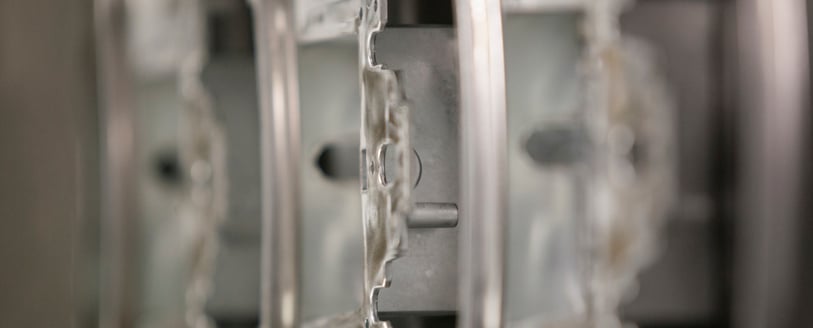As winner of numerous international awards, Bruschi Spa is known for its innovative approach in design and technology. We are glad to share our insights and experiences with the industry members.
Shrinkage porosity: causes and remedies
Shrinkage porosity defects are cavities inside components which can cause material weakening and, if positioned on surface, can worsen aesthetic quality and corrosion resistance.
Identifying cavities size, shape and surface, is crucial to point out which defect is occurring and to define its cause.
However it is important to distinguish shrinkage porosity from air entrapment: holes caused by air entrapment have rounded shapes, while lack of material of shrinkage porosity have angular surfaces.
For further information about air entrapment click on the previous link, otherwise continue reading.

Now let’s deeply analyze shrinkage porosity defect
How is shrinkage porosity caused?
Shrinkage porosity appears during material solidification phase, which begins with mold filling phase and ends when every part of the material is completely solidified. The cause of its creation is material shrink and, for this reason, porosity is as intense as shrink rate is high.
The metal injected inside the mold starts its cooling phase when it is in contact with walls. The thermal exchange with mold walls causes metal solidification from external surface to the core. During this phase metal volume decreases causing a convective gradient toward external surface. For this reason porosities are near inner and massive parts of the component.
In zinc high pressure die casting, in particular for zinc alloys die casting, shrink rate is really important.
Other characteristics of zinc HPDC that can amplify shrinkage porosity are zinc high thermal conductivity, small gate area of runners and not correct cooling of mold.
When mold design and operative parameters are not appropriate zinc alloys can solidify really quickly, thermal gradient can be very high, hotspot could be generated and gates can be the first part of casting that solidify, in particular this last aspect leads to diminish compressing effect of stroke. This means shrinkage porosity.
Once analyzed these points, it is important to work on component geometry that is fundamental because some types of geometries can be more critical than others: for example heavy wall thickness and cross-sections too thick.
Shrinkage porosity in a new or already existent product
For a new product, in order to avoid defects, simulation analysis is necessary during design phase. If the component is already existing, it is necessary to test the mold and analyze castings affected by shrinkage porosity, in particular dimensions and defects position.
How to avoid defects with simulation for a new product
Shrinkage porosity can be eliminated ensuring the flow of liquid metal under high pressure during solidification phase. Specialists should use simulation software in order to obtain an analysis for casting solidification phase.
Strictly regarding shrinkage porosity with die casting simulation it is possible to identify shapes and locations of porosity and predict air entrapment tracking flows.
In high pressure die casting process, with die casting simulation tools, it is possible to optimize:
- Casting and molds geometry design
- Casting parameters
- Gating and cooling systems
- Die conformation
Data results are necessary to investigate the problem and to diagnose the process and predict defects.
How to fix shrinkage porosity for an existent product?
Sometimes it could happen that a supplier substitutes another supplier for a particular part. In general this can be for non-compliance issues for different reasons: one of these could be shrinkage porosity. In this case the new supplier has to work directly on products, trying to find the better solution.
For example if cavities have large dimensions and are always in the same position near gates, it could be necessary to act on different factors and in particular on runners and gates geometries. On the contrary if porosities have different frequencies and positions into casting, specialists should work on machines and operative parameters.
To avoid shrinkage porosity, for an existing part, it is possible to work in two different ways:
- Modifying die casting machines parameters
- Modifying the mold
Hereunder a focus to explain which changes are possible.
Modifying die casting machines parameters
Beforehand intervening on machine parameters it is important to check the correct functionality of it. In fact really often porosity issues can be caused by an incorrect or absent machine maintenance.
Once suppliers have verified the correct machine functionality, they can modify the following elements:
- Working pressure: increasing working pressure has always positive effects on shrinkage porosity issue, but it is important not to exceed machine locking force. To increase working pressure it is possible to decrease stroke diameter or increase hydraulic pressure.
- Working temperature: by modifying temperature and type of cooling fluid it is possible to cool down hotspots positioned in porosity zones.
Summarizing working pressure and temperature diminish porosity in terms of machines parameters.
Modifying the mold
Changing mold morphology means to avoid issues such as shrinkage porosity. Specialists can operate on:
- Feeding channel: if porosities are near injection gate the simplest and most effective way is to modify mold runner in order to slow down feeding channel solidification and increase compressing effect of stroke
- Cooling system: as for machine the aim is to reach porosities zones in order to cool down casting hotspots
Many benefits are given by these simulation software: for example less rejected products, shorten delivery time and improved quality. These predictions lead to significant cost reduction, improving material and energy consumption and reducing scraps.
If you want to be updated on trends and innovations in die casting industries and learn more about die casting defects, please subscribe to our blog.

